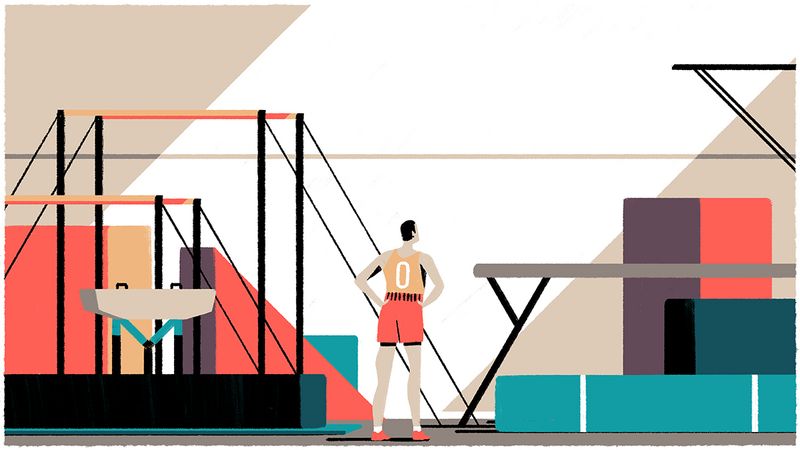THE JOURNAL

Illustration by Mr Tommy Parker
No-equipment workouts such as calisthenics and yoga are becoming increasingly popular .
For everyone from athletes to soldiers, physical training has persisted for decades as a simple product of lifting progressively heavier metal to build strength plus running sprints to keep the body lean. It’s a routine the modern commercial gym was built around in the Pumping Iron era of 1970s Venice, California, and it has bored countless men to death – or lethargy, at least – ever since.
Navigate the class schedule at your nearest upscale sweatbox, however, and you’ll see how things are changing. Many men are ditching the weights room and the track in favour of bodyweight exercises such as calisthenics (think press-ups, pull-ups, leg raises and handstands), gymnastic strength training and strong yoga, which can be performed in the gym or at home. Growing interest has meant that classes in “animal flow” or “primal movement” at Blok, Equinox and Third Space are now among their most popular draws, and the big boxing gyms are loading up on monkey bars and dangling TRX bands, ropes and rings to satisfy demand.
This shift is partly down to our exposure to different kinds of physical activity through social media. But top-level training, built on a more scientific and less dogmatic approach, has changed dramatically in the past five to 10 years, inspiring mere mortals to follow suit. Basketball player Mr LeBron James has put his sporting success and healthy mind and body down to yoga, a practice Arsenal FC and the All Blacks rugby team have built into their training programmes. Meanwhile, mixed martial artist Mr Conor McGregor works with voguish movement guru Mr Ido Portal.
It’s easy to see why no-equipment workouts are popular. They’re suitable for any ability level, can be done anywhere and don’t require gym membership. But they also offer a vastly superior workout. Here’s why.

IT’S MORE INTERESTING
“I’m the strongest I’ve ever been, and it’s mainly because I’m more interested in doing what I do now than in lifting weights,” says Mr Patrick Beach, an elite yoga instructor and Virgin Active’s yoga ambassador, who recently helped design its range of strong yoga classes. Mr Beach played semi-pro basketball at university and was conditioned on a simple training schedule of court time, weights and track sprints, which left him with poor mobility and flexibility, and feeling bored by training. Now he gets everything he needs from yoga and rock climbing. Try setting yourself a goal such as a planche, a press to handstand or a muscle-up, and you’ll be far more motivated by your progress than the pursuit of bigger weights or lowering the pin in machines.

IT MAKES YOU STRONGER
A free weights gym-bro might be able to bench twice their bodyweight, but where do you go from there? “If you bench press, the only thing you could do is bench more weight,” says Mr Beach. “If you do squats, the only thing you could do is squat more weight.” As a result, weight lifters tend to have tight joints and restricted movement – terrible shoulder extension, for example – and less transferrable, practical strength. “The more you play around with different variations of handstands or pull-ups, you can progress to completely different levels of movement,” he says. Calisthenics exercises and yoga flows condition your body to perform in a way that it does day to day, with compound movements that balance large and small muscles with one another, rather than isolating them, as you would in a biceps curl. That gets you fitter in a way that’s relevant to everyday life, whether you’re picking up furniture or carrying a small child, but also to any kind of sport. The skill difficulty itself demands more mechanical energy, too.

DO IT ANYWHERE
Do you have a body, with arms and legs? You’re good to go. The beauty of calisthenics and yoga is that they require no special equipment. “I can do the same practices here in my house in Los Angeles as I do when I’m travelling,” says Mr Beach. “I can do them in a hotel room, I can do them in a gym. You don’t need all this equipment. You can really participate anywhere. It gives you so much more freedom.” Mr Beach’s go-to on-the-road strength routine takes in handstand variations, tuck planche, L-sit holds, backbends and stretching, plus a gruelling press-up cycle.

IT MAKES YOU THINK
Skill work helps with focus and concentration while you struggle to maintain proper form. It develops mental skills that transfer directly to life off the mat and outside the gym, too. Exploring body movement gives you an understanding of your natural strengths and weaknesses, and the connections of body and mind, says Mr Beach. “It’s about learning about yourself through the process of training, which is more interesting than just trying really hard,” he says.
Keep up to date with The Daily by signing up to our weekly email update. Click here to update your email preferences